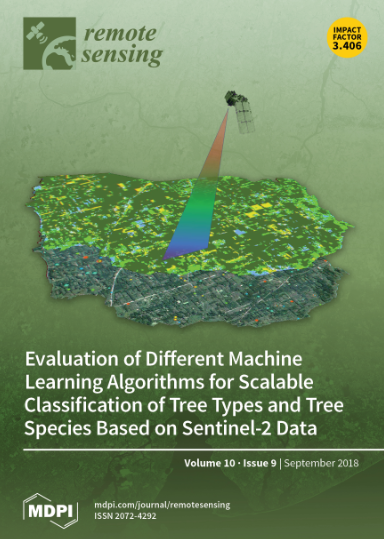澳大利亚气象局的 Himawari-8 海洋表面温度产品
IF 4.2
2区 地球科学
Q2 ENVIRONMENTAL SCIENCES
引用次数: 0
摘要
作为对综合海洋观测系统(IMOS)的贡献,气象局推出了经重新处理的向日葵-8 号卫星海面温度(SST)新产品。利用辐射传输模型和贝叶斯云清除方法,每 10 分钟从地球静止卫星 Himawari-8 获取一次 SST。本文介绍的传感器特定误差统计(SSES)经验模型用于计算检索到的 SST 的偏差和标准偏差。本文讨论了 SST 检索和合成方法以及验证结果。在卫星天顶角小于 60°、质量等级大于 2 级的情况下,经热分层调整后的向日葵-8 号二级产品(L2P)表层海温与原地海温质量监测(iQuam)原地海温数据集的月度统计比较显示,偏差校正后的日间/夜间平均偏差为-0.2/-0.1 K,标准偏差为 0.4-0.7 K。为便于使用,这些原始分辨率的海温数据已采用本文介绍的一种方法进行了合成,保留了检索到的测量数据,形成了每小时、每 4 小时和每天的海温产品,并投影到 IMOS 0.02 度的矩形网格上。平均而言,4 小时产品覆盖的 IMOS 域面积≈10%,而一夜合成数据覆盖的 IMOS 域面积比典型的 1 小时合成数据≈25%。所有可用的 Himawari-8 数据都经过重新处理,时间跨度为 2015 年 9 月至 2022 年 12 月。新开发的向日葵-8 SST 数据的时间分辨率为 10 分钟,因此能够生成空间覆盖范围更广的每日合成数据,有效填补了瞬时云遮挡造成的 SST 缺口。新的向日葵-8 产品的预期效益包括提高 IMOS OceanCurrent 等应用的数据质量,以及调查近海岸地区的海洋热应力、海洋热浪和海洋上升流。本文章由计算机程序翻译,如有差异,请以英文原文为准。
Himawari-8 Sea Surface Temperature Products from the Australian Bureau of Meteorology
As a contribution to the Integrated Marine Observing System (IMOS), the Bureau of Meteorology introduces new reprocessed Himawari-8 satellite-derived Sea Surface Temperature (SST) products. The Radiative Transfer Model and a Bayesian cloud clearing method is used to retrieve SSTs every 10 min from the geostationary satellite Himawari-8. An empirical Sensor Specific Error Statistics (SSES) model, introduced herein, is applied to calculate bias and standard deviation for the retrieved SSTs. The SST retrieval and compositing method, along with validation results, are discussed. The monthly statistics for comparisons of Himawari-8 Level 2 Product (L2P) skin SST against in situ SST quality monitoring (iQuam) in situ SST datasets, adjusted for thermal stratification, showed a mean bias of −0.2/−0.1 K and a standard deviation of 0.4–0.7 K for daytime/night-time after bias correction, where satellite zenith angles were less than 60° and the quality level was greater than 2. For ease of use, these native resolution SST data have been composited using a method introduced herein that retains retrieved measurements, to hourly, 4-hourly and daily SST products, and projected onto the rectangular IMOS 0.02 degree grid. On average, 4-hourly products cover ≈10% more of the IMOS domain, while one-night composites cover ≈25% more of the IMOS domain than a typical 1 h composite. All available Himawari-8 data have been reprocessed for the September 2015–December 2022 period. The 10 min temporal resolution of the newly developed Himawari-8 SST data enables a daily composite with enhanced spatial coverage, effectively filling in SST gaps caused by transient clouds occlusion. Anticipated benefits of the new Himawari-8 products include enhanced data quality for applications like IMOS OceanCurrent and investigations into marine thermal stress, marine heatwaves, and ocean upwelling in near-coastal regions.
求助全文
通过发布文献求助,成功后即可免费获取论文全文。
去求助
来源期刊

Remote Sensing
REMOTE SENSING-
CiteScore
8.30
自引率
24.00%
发文量
5435
审稿时长
20.66 days
期刊介绍:
Remote Sensing (ISSN 2072-4292) publishes regular research papers, reviews, letters and communications covering all aspects of the remote sensing process, from instrument design and signal processing to the retrieval of geophysical parameters and their application in geosciences. Our aim is to encourage scientists to publish experimental, theoretical and computational results in as much detail as possible so that results can be easily reproduced. There is no restriction on the length of the papers. The full experimental details must be provided so that the results can be reproduced.
 求助内容:
求助内容: 应助结果提醒方式:
应助结果提醒方式:


